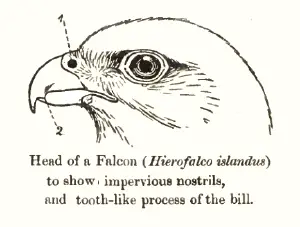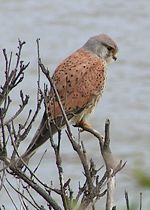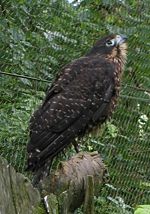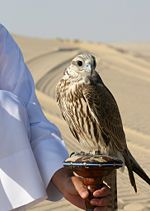Falcon
- For other uses, see Falcon (disambiguation).
- "Tiercel" redirects here.
| Falcons | ||||||||||||
|---|---|---|---|---|---|---|---|---|---|---|---|---|
| Mauritius Kestrel, Falco punctatus. This small falcon was nearly extinct in 1974. Mauritius Kestrel, Falco punctatus.
This small falcon was nearly extinct in 1974. | ||||||||||||
| Scientific classification | ||||||||||||
| ||||||||||||
|
About 37; see text. | ||||||||||||
|
A Falcon is a species of raptors in the genus Falco. The word comes from their Latin name falco, related to Latin falx ("scythe") because of the shape of these birds' wings.
Overview
Adult falcons have thin tapered wings, which enable them to fly at high speed and to change direction rapidly. Fledgling falcons, in their first year of flying, have longer flight feathers which makes their configuration more like that of a general-purpose bird such as a broadwing. This is to make it easier for them to fly while learning the exceptional skills required to be effective hunters in their adult configuration. Technically a falcon's wings are shaped more like a scythe than a sickle. Common misconceptions of the difference of a scythe and sickle are the cause of the misconception of the shape of the falcons wings.
Peregrine Falcons are the fastest-moving creatures on Earth. Other falcons include the Gyrfalcon, Lanner Falcon, and the Merlin. Some small insectivorous falcons with long narrow wings are called hobbies, and some which hover while hunting for small rodents are called kestrels. The falcons are part of the family Falconidae, which also includes the caracaras, Laughing Falcon, forest falcons, and falconets.
The traditional term for a male falcon is tercel (UK spelling) or tiercel (US spelling), from Latin tertius = third because of the belief that only one in three eggs hatched a male bird.[2] [3] Some sources give the etymology as deriving from the fact that a male falcon is approximately one third smaller than the female.
A falcon chick, especially one reared for falconry, that is still in its downy stage is known as an eyas[4][5] (sometimes spelt eyass). The word arose by mistaken division of Old French un niais, from Latin presumed *nidiscus ("nestling," from nidus = nest).
The technique of hunting with trained captive birds of prey is known as falconry.
In February 2005 the Canadian scientist Dr Louis Lefebvre announced a method of measuring avian intelligence in terms of their innovation in feeding habits. The falcon and crow family scored highest on this scale [1].
Systematics and evolution
Compared to other birds of prey, the fossil record of the falcons is not well distributed in time. The oldest fossils tentatively assigned to this genus are from the Late Miocene, less than 10 million years ago. This coincides with a period in which many modern genera of birds became recognizable in the fossil record. The falcon lineage - probably of North American or African, possibly Middle Eastern or European origin given the distribution of fossil and living Falco taxa - is likely to be somewhat older however.
Falcons are roughly divisible into three or four groups. The first contains the kestrels (probably excepting the American Kestrel: Groombridge et al. 2002); usually small and stocky falcons of mainly brown upperside color and sometimes sexually dimorphic; three African species that are generally grey in color stand apart from the typical members of this group. Kestrels feed chiefly on terrestrial vertebrates and invertebrates of appropriate size, such as rodents, reptiles, or insects.
The second group contains slightly larger (on average) and more elegant species, the hobbies and relatives. These birds are characterized by considerable amounts of dark slaty grey in their plumage; the malar area is nearly always black. They feed mainly on smaller birds.
Third are the Peregrine Falcon and its relatives: powerful birds, often the size of small hawks, they also have a black malar area (except some very light color morphs), and often a black cap also. Otherwise, they are somewhat intermediate between the other groups, being chiefly medium grey with some lighter or brownish colours on the upper side. They are on average more delicately patterned than the hobbies and if the hierofalcons are excluded (see below), this group contains typically species with horizontal barring on the underside. As opposed to the other groups, where tail colour varies much in general but little according to evolutionary relatedness[2], the tails of the large falcons are quite uniformly dark grey with rather inconspicuous black banding and small white tips, though this is probably plesiomorphic. These large Falco feed on mid-sized birds and terrestrial vertebrates, taking prey of up to 5-pound sage grouse size.
Very similar to these and sometimes included therein are the 4 or so species of hierofalcons (literally, "hawk-falcons"). They represent taxa with usually more phaeomelanins which impart reddish or brown colors, and generally more strongly patterned plumage reminiscent of hawks. Notably, their undersides have a legthwise pattern of blotches, lines or arrowhead marks.
While these three or four groups, loosely circumscribed, are an informal arrangement, they are probably contain several distinct clades in their entirety. A study of mtDNA cytochrome b sequence data of some kestrels (Groombridge et al. 2002) identified a clade containing the Common Kestrel and related "malar-striped" species, to the exclusion of such taxa as the Greater Kestrel (which lacks a malar stripe), the Lesser Kestrel (which is very similar to the Common but also has no malar stripe), and the American Kestrel. The latter species has a malar stripe, but its color pattern - apart from the brownish back - and notably also the black feathers behind the ear, which never occur in the true kestrels, are more reminiscent of some hobbies. The malar-striped kestrels apparently split from their relatives in the Gelasian, roughly 2.5-2 mya, and are apparently of tropical East African origin. The entire "true kestrel" group - excluding the American species - is probably a distinct and quite young clade, as also suggested by their numerous apomorphies.
Other studies[3] have confirmed that the hierofalcons are a monophyletic group - and, incidentially, that hybridization is quite frequent at least in the larger species falcon species. Initial studies of mtDNA cytochrome b sequence data suggested that the hierofalcons are basal among living falcons[4]. This is now known to be an erroneous result due to the presence of a numt (Wink & Sauer-Gürth 2000); in reality the hierofalcons are a rather young group, originating maybe at the same time as the start of the main kestrel radiaton, about 2 million years ago. This lineage seems to have gone nearly extinct at some point in the past; the present diversity is of very recent origin, though little is known about their fossil history (Nittinger et al. 2005).
The phylogeny and delimitations of the Peregrine and hobbies groups is more problematic. Molecular studies have only been conducted on a few species, and namely the morphologically ambiguous taxa have often been little researched. The morphology of the syrinx, which contributes well to resolving the overall phylogeny of the Falconidae[5], is not very informative in the present genus. Nonetheless, a core group containing the Peregrine and Barbary falcons which in turn group with the hierofalcons and the more distant Prairie Falcon (which was sometimes placed with the hierofalcons, even though it is entirely distinct biogeographically), as well as at least most of the "typical" hobbies, are confirmed to be monophyletic as suspected[6].
Given that the American Falcos of today belong to the Peregrine group or are apparently more basal species, it seems that the initially most successful evolutionary radiation was an Holarctic one that originated possibly around central Eurasia or in (northern) Africa. One or several lineages were present in North America by the Early Pliocene at latest.
In conclusion, the origin of today's major Falco groups - the "typical" hobbies and kestrels for example, or the Peregine-hierofalcon complex, or the Aplomado Falcon lineage - can be quite confidently placed from the Miocene-Pliocene boundary through the Zanclean and Piacenzian and just into the Gelasian, that is from about 8 to 2.4 million years ago, when the malar-striped kestrels diversified. Some groups of falcons, such as the hierofalcon complex or the Peregrine-Barbary superspecies have only evolved in more recent times; the species of the former seem to be a mere 120.000 years old or so (Nittinger et al. 2005).
Species
The sequence follows the taxonomic order of White et al. (1996), except for adjustments in the kestrel sequence.
- Madagascar Kestrel, Falco newtoni
- Seychelles Kestrel, Falco araea
- Mauritius Kestrel, Falco punctatus
- Réunion Kestrel, Falco duboisi - extinct (c.1700)
- Spotted Kestrel, Falco moluccensis
- Nankeen Kestrel or Australian Kestrel, Falco cenchroides
- Common Kestrel, Falco tinnunculus
- Rock Kestrel, Falco (tinnunculus) rupicolus
- Greater Kestrel, Falco rupicoloides
- Fox Kestrel, Falco alopex
- Lesser Kestrel, Falco naumanni
- Grey Kestrel, Falco ardosiaceus
- Dickinson's Kestrel, Falco dickinsoni
- Banded Kestrel, Falco zoniventris
- Red-necked Falcon, Falco chicquera
- African Red-necked Falcon, Falco (chicquera) ruficollis
- Red-footed Falcon, Falco vespertinus
- Amur Falcon, Falco amurensis
- Eleonora's Falcon, Falco eleonorae
- Sooty Falcon, Falco concolor
- American Kestrel or "Sparrow Hawk," Falco sparverius
- Aplomado Falcon, Falco femoralis
- (American) Merlin or "Pigeon Hawk," Falco columbarius
- Eurasian Merlin, Falco (columbarius) aesalon
- Bat Falcon, Falco rufigularis
- Orange-breasted Falcon, Falco deiroleucus
- Eurasian Hobby, Falco subbuteo
- African Hobby, Falco cuvierii
- Oriental Hobby, Falco severus
- Australian Hobby, Falco longipennis
- New Zealand Falcon, Falco novaeseelandiae
- Brown Falcon, Falco berigora
- Grey Falcon, Falco hypoleucos
- Black Falcon, Falco subniger
- Lanner Falcon, Falco biarmicus
- Laggar Falcon, Falco jugger
- Saker Falcon, Falco cherrug
- Gyrfalcon, Falco rusticolus
- Prairie Falcon, Falco mexicanus
- Peregrine Falcon or "Duck Hawk," Falco peregrinus
- Peale's Falcon, Falco peregrinus pealei
- Pallid Falcon, Falco peregrinus cassini var. kreyenborgi
- Barbary Falcon, Falco (peregrinus) pelegrinoides
- Taita Falcon, Falco fasciinucha
Fossil record
- ?Falco medius (Late Miocene of Cherevichnyi, Ukraine)[7]
- ?Falco sp. (Late Miocene of Idaho)[8]
- Falco sp. (Early[9] Pliocene of Kansas)[10]
- Falco sp. (Early Pliocene of Bulgaria - Early Pleistocene of Spain and Czechia)[11]
- Falco oregonus (Early/Middle Pliocene of Fossil Lake, Oregon) - possibly not distinct from a living species
- Falco umanskajae (Late Pliocene of Kryzhanovka, Ukraine) - includes "Falco odessanus," a nomen nudum[12]
- ?Falco bakalovi (Late Pliocene of Varshets, Bulgaria)[13]
- Falco antiquus (Middle Pleistocene of Noailles, France and possibly Horvőlgy, Hungary)[14]
- Cuban Kestrel, Falco kurochkini (Late Pleistocene/Holocene of Cuba, West Indies)
Several more paleosubspecies of extant species also been described; see species accounts for these.
"Sushkinia" pliocaena from the Early Pliocene of Pavlodar (Kazakhstan) appears to be a falcon of some sort. It might belong into this genus or a closely related one (Becker 1987). In any case, the genus name Sushkinia is invalid for this animal because it had already been allocated to a prehistoric dragonfly relative.
The supposed "Falco" pisanus was actually a pigeon of the genus Columba, possibly the same as Columba omnisanctorum which in that case would adopt the older species name of the "falcon" (Mlíkovský 2002). The Eocene fossil "Falco" falconellus (or "F." falconella) from Wyoming is a bird of uncertain affiliations, maybe a falconid, maybe not; it certainly does not belong into this genus. "Falco" readei is now considered a paleosubspecies of the Yellow-headed Caracara (Milvago chimachima).
Footnotes
- ↑ [1] AAAS Annual Meeting, 2005.
- ↑ For example, tail colour in the Common and Lesser Kestrels is absolutely identical, yet they do not seem too closely related (Groombridge et al. 2002). On the other hand, the Fox and Greater Kestrels can be told apart at first glance by their tail colours, but not by much else; they might be very close relatives and are probably much closer to each other than the Lesser and Common Kestrels.
- ↑ Helbig et al. (1994), Wink et al. (1998), Wink & Sauer-Gürth (2000), Wink et al. (2004), Nittinger et al. (2005)
- ↑ E.g. Helbig et al. (1994), Wink et al. (1998)
- ↑ See Griffiths (1999), Griffiths et al. (2004).
- ↑ Helbig et al. (1994), Wink et al. (1998)
- ↑ IZAN 45-4033: left carpometacarpus. Small species; possibly closer to kestrels than to peregrine lineage or hierofalcons, but may be more basal altogether due to its age.(Becker 1987, Mlíkovský 2002).
- ↑ IMNH 27937. A coracoid of a Merlin-sized species. It seems not close to F. columbarius or the Recent North American species (Becker 1987).
- ↑ Fox Canyon Local Fauna, 4.3–4.8 million years ago: see Martin et al. (2000).
- ↑ UMMP V27159, V29107, V57508-V57510, V57513/V57514[verification needed]: some limb bones. Slightly smaller than a Merlin and more robust than American Kestrel, and seems not too distant from F. columbarius.(Feduccia 1970)
- ↑ A hierofalcon (Mlíkovský 2002)? If so, probably not close to the living species but an earlier divergence that left no descendants; might be more than one species due to large range in time and/or include common ancestor of hierofalcons and Peregrine-Barbary complex (Nittinger et al. 2005).
- ↑ NNPM NAN 41-646. Almost complete left tarsometatarsus. Probably a prehistoric hobby, perhaps less specialized for bird hunting.(Sobolev 2003)
- ↑ Status, especially distinctness from F. antiquus, requires confirmation (Mlíkovský 2002).
- ↑ Supposedly a Saker Falcon paleosubspecies (Mlíkovský 2002), but this is not too likely due to the probable Eemian origin of that species (Nittinger et al. 2005).
ReferencesISBN links support NWE through referral fees
- Becker, Jonathan J. (1987): Revision of "Falco" ramenta Wetmore and the Neogene evolution of the Falconidae. Auk 104(2): 270-276. PDF fulltext
- Feduccia, J. Alan (1970): Some birds of prey from the Upper Pliocene of Kansas. Auk 87(4): 795-797. PDF fulltext
- Griffiths, Carole S. (1999): Phylogeny of the Falconidae inferred from molecular and morphological data. Auk 116(1): 116–130. PDF fulltext
- Griffiths, Carole S.; Barrowclough, George F.; Groth, Jeff G. & Mertz, Lisa (2004): Phylogeny of the Falconidae (Aves): a comparison of the efficacy of morphological, mitochondrial, and nuclear data. Molecular Phylogenetics and Evolution 32(1): 101–109. Digital object identifier (DOI): 10.1016/j.ympev.2003.11.019 (HTML abstract)
- Groombridge, Jim J.; Jones, Carl G.; Bayes, Michelle K.; van Zyl, Anthony J.; Carrillo, José; Nichols, Richard A. & Bruford, Michael W. (2002): A molecular phylogeny of African kestrels with reference to divergence across the Indian Ocean. Molecular Phylogenetics and Evolution 25(2): 267–277. DOI:10.1016/S1055-7903(02)00254-3 (HTML abstract)
- Helbig, A.J.; Seibold, I.; Bednarek, W.; Brüning, H.; Gaucher, P.; Ristow, D.; Scharlau, W.; Schmidl, D. & Wink, Michael (1994): Phylogenetic relationships among falcon species (genus Falco) according to DNA sequence variation of the cytochrome b gene. In: Meyburg, B.-U. & Chancellor, R.D. (eds.): Raptor conservation today: 593-599. PDF fulltext
- Martin, R.A.; Honey, J.G. & Pelaez-Campomanes, P. (2000): The Meade Basin Rodent Project; a progress report. Kansas Geologial Survey Open-file Report 2000-61[verification needed]. Paludicola 3(1): 1-32.
- Mlíkovský, Jirí (2002): Cenozoic Birds of the World, Part 1: Europe. Ninox Press, Prague. ISBN 80-901105-3-8 PDF fulltext
- Nittinger, F.; Haring, E.; Pinsker, W.; Wink, Michael & Gamauf, A. (2005): Out of Africa? Phylogenetic relationships between Falco biarmicus and other hierofalcons (Aves Falconidae). Journal of Zoological Systematics and Evolutionary Research 43(4): 321-331. Digital object identifier (DOI): 10.1111/j.1439-0469.2005.00326.x PDF fulltext
- Sobolev, D.V. (2003): Новый вид плиоценового сокола (Falconiformes, Falconidae) [A new species of Pliocene falcon (Falconiformes, Falconidae)] Vestnik zoologii 37(6): 85–87. [Russian with English abstract] PDF fulltext
- White, Clayton M.; Olsen, Penny D. & Kiff, Lloyd F. (1994): Family Falconidae. In: del Hoyo, Josep; Elliott, Andrew & Sargatal, Jordi (editors): Handbook of Birds of the World, Volume 2 (New World Vultures to Guineafowl): 216-275, plates 24-28. Lynx Edicions, Barcelona. ISBN 84-87334-15-6
- Wink, Michael & Sauer-Gürth, Hedi (2000): Advances in the molecular systematics of African raptors. In: Chancellor, R.D. & Meyburg, B.-U. (eds): Raptors at Risk: 135-147. WWGBP/Hancock House, Berlin/Blaine. PDF fulltext
- Wink, Michael; Seibold, I.; Lotfikhah, F. & Bednarek, W. (1998): Molecular systematics of holarctic raptors (Order Falconiformes). In: Chancellor, R.D., Meyburg, B.-U. & Ferrero, J.J. (eds.): Holarctic Birds of Prey: 29-48. Adenex & WWGBP. PDF fulltext
- Wink, Michael; Sauer-Gürth, Hedi; Ellis, David & Kenward, Robert (2004): Phylogenetic relationships in the Hierofalco complex (Saker-, Gyr-, Lanner-, Laggar Falcon). In: Chancellor, R.D. & Meyburg, B.-U. (eds.): Raptors Worldwide: 499-504. WWGBP, Berlin. PDF fulltext
External links
- Falconidae videos on the Internet Bird Collection
- The Raptor Resource Project Peregrine, owl, eagle and osprey cams, facts, and other resources.
- [6] Recording of a Falcon mating call.
Credits
New World Encyclopedia writers and editors rewrote and completed the Wikipedia article in accordance with New World Encyclopedia standards. This article abides by terms of the Creative Commons CC-by-sa 3.0 License (CC-by-sa), which may be used and disseminated with proper attribution. Credit is due under the terms of this license that can reference both the New World Encyclopedia contributors and the selfless volunteer contributors of the Wikimedia Foundation. To cite this article click here for a list of acceptable citing formats.The history of earlier contributions by wikipedians is accessible to researchers here:
The history of this article since it was imported to New World Encyclopedia:
Note: Some restrictions may apply to use of individual images which are separately licensed.




